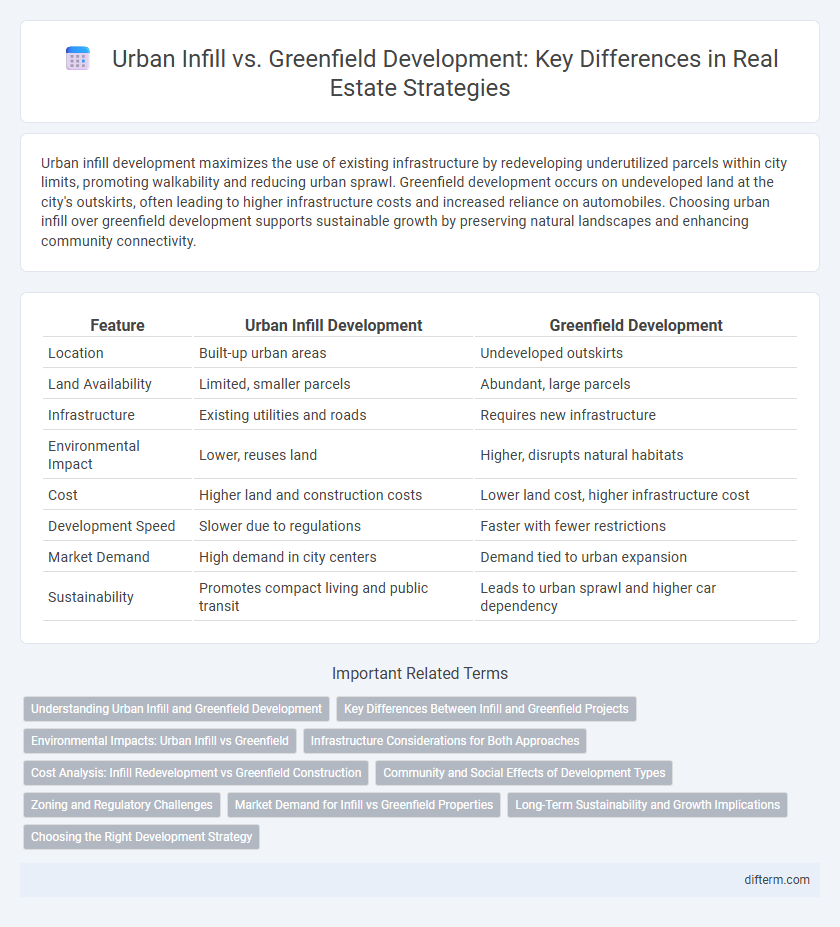Urban infill development maximizes the use of existing infrastructure by redeveloping underutilized parcels within city limits, promoting walkability and reducing urban sprawl. Greenfield development occurs on undeveloped land at the city's outskirts, often leading to higher infrastructure costs and increased reliance on automobiles. Choosing urban infill over greenfield development supports sustainable growth by preserving natural landscapes and enhancing community connectivity.
Table of Comparison
| Feature | Urban Infill Development | Greenfield Development |
|---|---|---|
| Location | Built-up urban areas | Undeveloped outskirts |
| Land Availability | Limited, smaller parcels | Abundant, large parcels |
| Infrastructure | Existing utilities and roads | Requires new infrastructure |
| Environmental Impact | Lower, reuses land | Higher, disrupts natural habitats |
| Cost | Higher land and construction costs | Lower land cost, higher infrastructure cost |
| Development Speed | Slower due to regulations | Faster with fewer restrictions |
| Market Demand | High demand in city centers | Demand tied to urban expansion |
| Sustainability | Promotes compact living and public transit | Leads to urban sprawl and higher car dependency |
Understanding Urban Infill and Greenfield Development
Urban infill development refers to the process of constructing new buildings within existing urban areas, utilizing vacant or underused parcels of land to maximize space efficiency and reduce urban sprawl. In contrast, greenfield development involves building on previously undeveloped land, often on the outskirts of cities, which can lead to increased infrastructure costs and environmental impacts. Understanding the distinctions between urban infill and greenfield development is crucial for sustainable real estate planning, balancing growth with resource conservation and community revitalization.
Key Differences Between Infill and Greenfield Projects
Infill development involves building on vacant or underutilized parcels within existing urban areas, promoting higher land use efficiency and leveraging existing infrastructure, whereas greenfield development occurs on previously undeveloped land, often on urban fringes, requiring new infrastructure investments. Infill projects typically support sustainable growth by reducing urban sprawl and preserving green spaces, while greenfield development allows for larger-scale planning with fewer constraints from surrounding structures. The main differences lie in their impact on land use patterns, infrastructure demands, environmental considerations, and potential effects on community dynamics.
Environmental Impacts: Urban Infill vs Greenfield
Urban infill development reduces environmental impacts by utilizing existing infrastructure and minimizing land consumption, leading to decreased habitat disruption and lower carbon emissions compared to greenfield development. Greenfield projects often result in significant loss of natural ecosystems, increased stormwater runoff, and higher transportation-related emissions due to suburban sprawl. Prioritizing urban infill supports sustainable land use, preserves open spaces, and enhances urban density, contributing to more efficient resource management and reduced ecological footprints.
Infrastructure Considerations for Both Approaches
Urban infill development leverages existing infrastructure such as roads, utilities, and public transit systems, reducing the need for extensive new construction and lowering overall costs. Greenfield development requires significant investment in infrastructure expansion, including new roadways, sewage, and utility networks, often leading to longer project timelines and higher environmental impact. Efficient infrastructure planning in urban infill projects enhances connectivity and supports sustainable urban growth while greenfield projects offer flexibility in design but demand comprehensive infrastructure development.
Cost Analysis: Infill Redevelopment vs Greenfield Construction
Urban infill redevelopment typically incurs higher upfront costs due to land acquisition complexities, demolition, and infrastructure upgrades, while greenfield construction benefits from undeveloped land with lower initial expenses. However, infill projects often yield greater long-term economic advantages through efficient land use, increased property values, and reduced infrastructure maintenance costs. Comprehensive cost analysis must consider factors such as site preparation, regulatory compliance, and potential for community revitalization to accurately compare infill and greenfield development financial viability.
Community and Social Effects of Development Types
Urban infill development enhances community cohesion by utilizing existing infrastructure, fostering walkability, and encouraging social interactions among residents. It minimizes urban sprawl, preserving green spaces and reducing environmental impact, which supports healthier and more sustainable neighborhoods. Greenfield development often leads to suburban expansion, potentially disrupting existing communities and increasing reliance on automobiles, which can fragment social networks and strain public services.
Zoning and Regulatory Challenges
Urban infill development faces significant zoning and regulatory challenges due to stricter land-use restrictions, existing infrastructure constraints, and complex approval processes aimed at preserving neighborhood character. Greenfield development typically benefits from more flexible zoning regulations and fewer historical land-use conflicts, allowing for easier subdivision and construction on undeveloped land. Navigating these zoning hurdles is critical for developers to optimize land use efficiency and comply with municipal growth management policies.
Market Demand for Infill vs Greenfield Properties
Market demand for urban infill properties has surged due to increased consumer preferences for walkable neighborhoods, access to public transit, and proximity to urban amenities, driving higher property values compared to greenfield developments. Greenfield properties often attract buyers seeking larger lots and new construction in suburban or rural settings, but this demand is tempered by longer commutes and limited infrastructure. Data from recent real estate market analyses reveal that infill developments typically achieve faster sales rates and higher absorption levels, reflecting stronger demand in established urban cores.
Long-Term Sustainability and Growth Implications
Urban infill development maximizes existing infrastructure, reducing urban sprawl and preserving natural landscapes, which supports long-term environmental sustainability. Greenfield development often leads to increased carbon emissions and habitat disruption due to new infrastructure demands, posing challenges for sustainable growth. Prioritizing urban infill enhances community resilience, optimizes land use, and aligns with smart growth principles fostering sustainable urban expansion.
Choosing the Right Development Strategy
Urban infill development maximizes land use within existing city infrastructure, reducing sprawl and promoting sustainable growth, while greenfield development offers more space and design freedom on undeveloped land. Selecting the right strategy depends on factors like project scale, environmental impact, infrastructure availability, and long-term urban planning goals. Effective decision-making balances community needs, cost efficiency, and regulatory constraints to optimize real estate value and urban livability.
urban infill vs greenfield development Infographic

 difterm.com
difterm.com